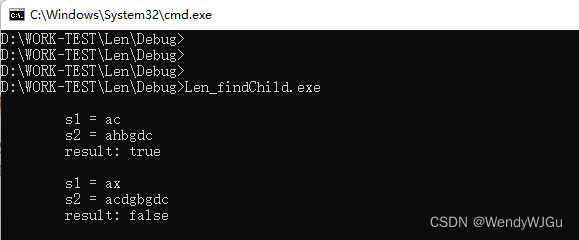判断子序列一个字符串是否是另一个字符串的子序列
解释:字符串的一个子序列是原始字符串删除一些(也可以不删除)字符,不改变剩余字符相对位置形成的新字符串。
如,"ace"是"abcde"的一个子序列。
"aec"不是"abcde"的子序列。
示例 1:
输入:s1 = "ac", s2 = "ahbgdc"
输出:true
示例 2:
输入:s = "ax", t = "acdgbgdc"
输出:false
解析:
按照s2的字符串顺序去找,如果s1是s2的子序列,那么一定能找到对应的s1中的所有字符,
如果遍历了s2,而s1中还有剩余的长度没有找到,那么说明s1不是s2的子序列。
示例源码:
// Len_findChild.cpp : 此文件包含 "main" 函数。程序执行将在此处开始并结束。
//#include <iostream>
#include <string>
using namespace std;
bool JudgeChildStr(string s, string t)
{int count = s.size() - 1;for (int i = t.size() - 1; i >= 0 && count >= 0; i--){if (t[i] == s[count]){count--;}}if (count < 0){return true;}return false;
}int main()
{string s1 = "ac";string s2 = "ahbgdc";bool bResult = JudgeChildStr(s1, s2);printf("\n\ts1 = %s \n\ts2 = %s \n\tresult: %s\n", s1.c_str(), s2.c_str(), (bResult==0)?("false"):("true"));s1 = "ax";s2 = "acdgbgdc";bResult = JudgeChildStr(s1, s2);printf("\n\ts1 = %s \n\ts2 = %s \n\tresult: %s\n", s1.c_str(), s2.c_str(), (bResult == 0) ? ("false") : ("true"));}执行结果:



![[算法每日一练]-双指针 (保姆级教程篇 1) #A-B数对 #求和 #元音字母 #最短连续子数组 #无重复字符的最长子串 #最小子串覆盖 #方块桶](http://pic.xiahunao.cn/[算法每日一练]-双指针 (保姆级教程篇 1) #A-B数对 #求和 #元音字母 #最短连续子数组 #无重复字符的最长子串 #最小子串覆盖 #方块桶)




数据增强)








(模拟,c++,vector建二叉树))


